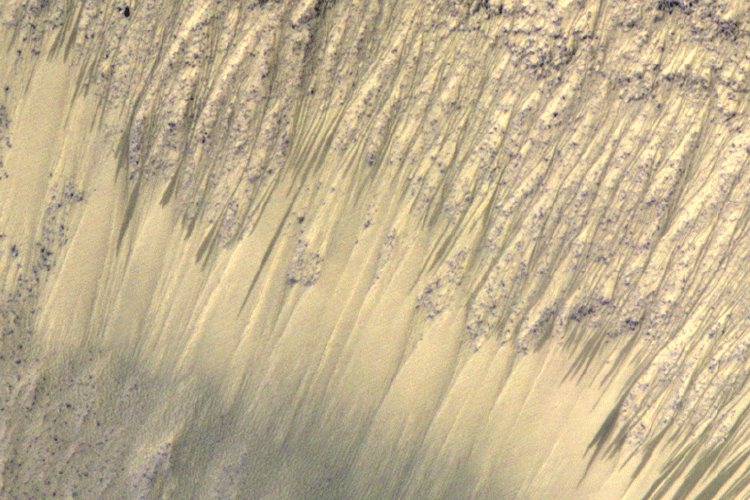Science News
Watery Mars
December 12, 2013
by Molly Michelson

Even though it gets all of the attention, Curiosity isn’t the only thing happening on or around the red planet next door. Over the past sixteen years, we’ve had eight other missions to Mars, including orbiting spacecrafts and grounded-based rovers, many of which continue to gather data for scientists to learn from each day.
This week at the American Geophysical Union Meeting (AGU) in San Francisco, scientists discussed what we’re learning from these non-Curiosity spacecraft. Their findings were also published this week in Nature Geoscience.
Often while looking at other worlds within or outside of our solar system, scientists search for evidence of water. The thinking is that where there’s water, there could be life (at least life as we know it). Evidence of frozen water at Mars’s poles might be old news, but researchers are starting to see ice and liquid water closer to the equator, too.
“The equatorial surface region of Mars has been regarded as dry, free of liquid or frozen water, but we may need to rethink that,” says Alfred McEwen of the University of Arizona, principal investigator for NASA’s Mars Reconnaissance Orbiter (MRO) High Resolution Imaging Science Experiment (HiRISE) camera.
What evidence has prompted this rethinking? Recurring Slope Lineae (RSL), found in the middle latitudes on steep equator-facing slopes. First reported two years ago, RSL are surface flows (see the HiRISE image above) that extend down rocky slopes in the summer, recede in the winter, and return in the spring. The team has been looking closer at these in Mars’s large canyon, Valles Marineris.
“The explanation that fits best is salty water is flowing down the slopes when the temperature rises,” McEwen says. “We still don't have any definite identification of water at these sites, but there's nothing that rules it out, either.
“Why do they matter to future exploration?” McEwan asks. “If we look into human exploration of Mars, the RSLs could tell us where to live. We can also add this area to the special regions that require extra planetary protection—we don’t want to contaminate the RSLs with Earthly microbes.”
Colin Dundas, another HiRISE team member and a scientist with the US Geological Survey, presented more evidence of water discovered far away from the poles—in the form of ice recently uncovered in impact craters.
Impacts of small asteroids or bits of comets dig many fresh craters on Mars every year. Twenty fresh craters have exposed bright ice previously hidden beneath the surface. Five were reported in 2009. The 15 newly reported ones are distributed over a wider range of latitudes and longitudes.
“The more we find, the more we can fill in a global map of where ice is buried,” says Dundas. “We’ve now seen icy craters down to 39 degrees north, more than halfway from the pole to the equator. They tell us that either the average climate over several thousand years is wetter than present or that water vapor in the current atmosphere is concentrated near the surface. Ice could have formed under wetter conditions, with remnants from that time persisting today, but slowly disappearing.”
Sixteen years with eyes on our closest neighbor—what will we discover in the next sixteen years? Life?